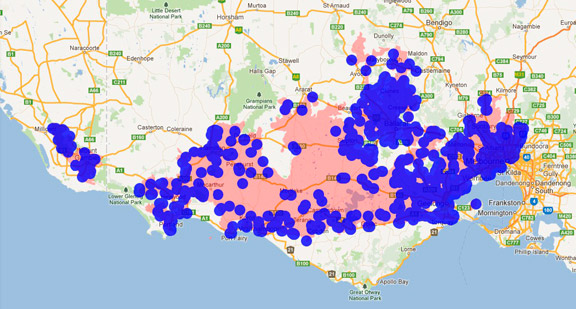A range of teacher professional learning programs will be developed to accompany the Biodiversity of the Western Volcanic Plains online outreach...


New Holland Honeyeater
Phylidonyris novaehollandiae
Breeds when nectar plants flower, mostly from July to December and again from March to May. Several broods may be produced in a year. A cup shaped nest is placed in a shrub or tree anywhere up to 6 metres high. Clutch size is 2-3 eggs which are incubated for 14-15 days. Both sexes feed the young. Young fly at 13-15 days.
| Details | Description |
| Type | Bird |
| Group | Honeyeater |
| Other Common Names | Yellow-winged Honeyeater |
| Identifying Characteristics | |
| Distinctive Markings | Large, golden wing panel. Flight and tail feathers have wide, golden outer margins. |
| Diet | Omnivore. Mostly nectar from flowers. Also feeds on fruit, insects and spiders. |
| Habitat | Heath, forests, woodland and gardens. Commonly associated with Grevillea and Banksia species. |
| Native Status | Native to Australia |
| Sounds | Abrupt, metallic "tjik" or "chwi"'. Long, whistled "tseee" often in flight. |
| Taxonomy | |
| Phylum | Chordata |
| Class | Aves |
| Order | Passeriformes |
| Family | Meliphagidae |
| Genus | Phylidonyris |
| Species | novaehollandiae |

Distribution maps indicate current and historic locations where species have been sighted.
Source: Atlas of Living Australia
| Conservation Status | |
| DEPI Advisory List | Not listed |
| FFG Act | Not listed |
| EPBC Act | Not listed |
The conservation status of species is listed within Victoria and Australia.
The Department of Environment and Primary Industry (DEPI) Advisory List consists of non-statutory advisory lists of rare or threatened flora and fauna within Victoria.
The Flora and Fauna Guarantee Act 1988 (FFG Act) lists threatened species in Victoria. Under the Act, an Action Statement is produced for each listed species.
The Environment Protection and Biodiversity Conservation Act 1999 (EPBC Act) is the Australian Government’s key piece of environmental legislation, listing nationally threatened native species and ecological communities.



